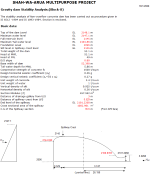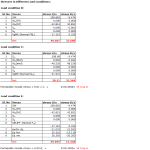Gravity Dam Stability Analysis

Description
SHAH-WA-ARUA MULTIPURPOSE PROJECT
Gravity dam Stability Analysis:(Block-8)
The stability analysis of Non-overflow concrete dam has been carried out as procedure given in IS 6512 -1984 and IS 1893-1984. Section is enclosed.
Basic data
- Top of the dam Level
- Maximum water level
- Full reservoir level
- Maximum Tail water level
- Foundation Level
- Silt level or Spillway crest level
- Total Height of the dam
- Head at MWL
- Head at FRL
- D/S slope
- Base width of dam
- Tail water depth for MWL
- Compressive strength of concrete fc
- Design horizontal seismic coefficient (?h)
- Design vertical seismic coefficient (?v=3/4 x ?h)
- Unit weight of concrete
- Unit weight of water
- Vertical density of silt
- Horizontal density of silt
- Section Modulus (Z)
- Distance of drainage gallery from U/S
- Distance of spillway crest from U/S
- End level of the spillway
- Cross sectional area of the spillway
- C.G of the Spillway section
Calculation Reference
Dam Design
Hydraulics
Non Overflow Concrete Dam
The stability analysis of a non-overflow concrete dam involves assessing the safety and stability of the dam under various loads and conditions, such as earthquakes and floods. The procedure for stability analysis is outlined in two Indian Standards: IS 6512-1984 and IS 1893-1984.
IS 6512-1984 provides guidelines for the design and construction of concrete dams, including the stability analysis. The stability analysis involves evaluating the stability against overturning, sliding, and deformation under various loading conditions. The analysis also considers the factors of safety and the effects of temperature changes, seepage, and differential settlement.
IS 1893-1984 provides guidelines for earthquake-resistant design of structures, including dams. The seismic analysis of a concrete dam involves assessing the response of the dam to ground motions and determining the seismic forces and moments acting on the dam. The analysis considers the dynamic properties of the dam and the foundation, as well as the effects of soil-structure interaction.
The stability analysis of a non-overflow concrete dam typically involves the following steps:
-
Determination of design loads, such as hydrostatic pressure, seismic loads, and temperature changes.
-
Calculation of the forces and moments acting on the dam, including the hydrostatic force, seismic force, and buoyancy force.
-
Calculation of the factors of safety against overturning, sliding, and deformation, using appropriate methods and criteria.
-
Evaluation of the effects of seepage, differential settlement, and other factors on the stability of the dam.
-
Design of the foundation and abutments to ensure stability and prevent failure.
The stability analysis of a non-overflow concrete dam is a complex process that requires expertise in civil engineering, geotechnical engineering, and earthquake engineering. The Indian Standards provide guidance and procedures for carrying out the analysis and ensuring the safety and stability of the dam.
Calculation Preview
Full download access to any calculation is available to users with a paid or awarded subscription (XLC Pro).
Subscriptions are free to contributors to the site, alternatively they can be purchased.
Click here for information on subscriptions.








